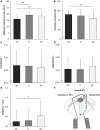Neuromuscular Properties of the Human Wrist Flexors as a Function of the Wrist Joint Angle
- PMID: 31497595
- PMCID: PMC6713036
- DOI: 10.3389/fbioe.2019.00181
Neuromuscular Properties of the Human Wrist Flexors as a Function of the Wrist Joint Angle
Abstract
The joint angle dependence of voluntary activation and twitch properties has been investigated for several human skeletal muscles. However, although they play a key role for hand function and possess a unique neural control compared to muscles surrounding other joint complexes, little is known about the wrist flexors innervated by the median nerve. Therefore, isometric voluntary and electrically evoked contractions of the wrist flexors were analyzed at three wrist joint angles (extension: -30°, neutral: 0°, flexion: 30°) to quantify the joint angle dependence of (i) voluntary activation (assessed via peripheral nerve stimulation and electromyography [EMG]), (ii) unpotentiated twitch torques, and (iii) potentiated twitch torques. Maximum voluntary torque was lower in extension compared to neutral and flexion. Although voluntary activation was generally high, data indicate that voluntary activation of the wrist flexors innervated by the median nerve was lower and the antagonist·agonist-1 EMG ratio was higher with the wrist joint in flexion compared to extension. Peak twitch torque, rate of twitch torque development, and twitch half-relaxation time increased, whereas electromechanical delay decreased from flexion to extension for the unpotentiated twitch torques. Activity-induced potentiation partly abolished these differences and was higher in short than long wrist flexors. Different angle-dependent excitatory and inhibitory inputs to spinal and supraspinal centers might be responsible for the altered activation of the investigated wrist muscles. Potential mechanisms were discussed and might have operated conjointly to increase stiffness of the flexed wrist joint. Differences in twitch torque properties were probably related to angle-dependent alterations in series elastic properties, actin-myosin interaction, Ca2+ sensitivity, and phosphorylation of myosin regulatory light chains. The results of the present study provide valuable information about the contribution of neural and muscular properties to changes in strength capabilities of the wrist flexors at different wrist joint angles. These data could help to understand normal wrist function, which is a first step in determining mechanisms underlying musculoskeletal disorders and in giving recommendations for the restoration of musculoskeletal function after traumatic or overuse injuries.
Keywords: activity-dependent potentiation; electrical stimulation; flexor carpi radialis; median nerve; muscle length; post-activation potentiation; twitch; voluntary activation.
Figures





Similar articles
-
Upper-limb surface electro-myography at maximum supination and pronation torques: the effect of elbow and forearm angle.J Electromyogr Kinesiol. 2002 Aug;12(4):275-85. doi: 10.1016/s1050-6411(02)00014-7. J Electromyogr Kinesiol. 2002. PMID: 12121684
-
Neuromechanical properties of the triceps surae in young and older adults.Exp Gerontol. 2013 Nov;48(11):1147-55. doi: 10.1016/j.exger.2013.07.007. Epub 2013 Jul 22. Exp Gerontol. 2013. PMID: 23886750
-
Wrist flexors are steadier than extensors.Int J Sports Med. 2011 Oct;32(10):754-60. doi: 10.1055/s-0031-1280777. Epub 2011 Sep 12. Int J Sports Med. 2011. PMID: 21913160
-
Roles of primate spinal interneurons in preparation and execution of voluntary hand movement.Brain Res Brain Res Rev. 2002 Oct;40(1-3):53-65. doi: 10.1016/s0165-0173(02)00188-1. Brain Res Brain Res Rev. 2002. PMID: 12589906 Review.
-
Post-activation Potentiation Versus Post-activation Performance Enhancement in Humans: Historical Perspective, Underlying Mechanisms, and Current Issues.Front Physiol. 2019 Nov 1;10:1359. doi: 10.3389/fphys.2019.01359. eCollection 2019. Front Physiol. 2019. PMID: 31736781 Free PMC article. Review.
Cited by
-
Effects of the Proprioceptive Neuromuscular Facilitation Contraction Sequence on Motor Skill Learning-Related Increases in the Maximal Rate of Wrist Flexion Torque Development.Front Hum Neurosci. 2021 Nov 3;15:764660. doi: 10.3389/fnhum.2021.764660. eCollection 2021. Front Hum Neurosci. 2021. PMID: 34803640 Free PMC article.
-
Changes in brain functional connectivity and muscle strength independent of elbow flexor atrophy following upper limb immobilization in young females.Exp Physiol. 2024 Sep;109(9):1557-1571. doi: 10.1113/EP091782. Epub 2024 Jun 27. Exp Physiol. 2024. PMID: 38935545 Free PMC article.
-
Multimodal Sensorimotor Integration of Visual and Kinaesthetic Afferents Modulates Motor Circuits in Humans.Brain Sci. 2021 Feb 3;11(2):187. doi: 10.3390/brainsci11020187. Brain Sci. 2021. PMID: 33546384 Free PMC article.
-
Quantifying the Elasticity Properties of the Median Nerve during the Upper Limb Neurodynamic Test 1.Appl Bionics Biomech. 2022 Mar 20;2022:3300835. doi: 10.1155/2022/3300835. eCollection 2022. Appl Bionics Biomech. 2022. PMID: 35355794 Free PMC article.
-
Is there an intermuscular relationship in voluntary activation capacities and contractile kinetics?Eur J Appl Physiol. 2020 Feb;120(2):513-526. doi: 10.1007/s00421-019-04299-z. Epub 2020 Jan 10. Eur J Appl Physiol. 2020. PMID: 31925519
References
LinkOut - more resources
Full Text Sources
Miscellaneous

